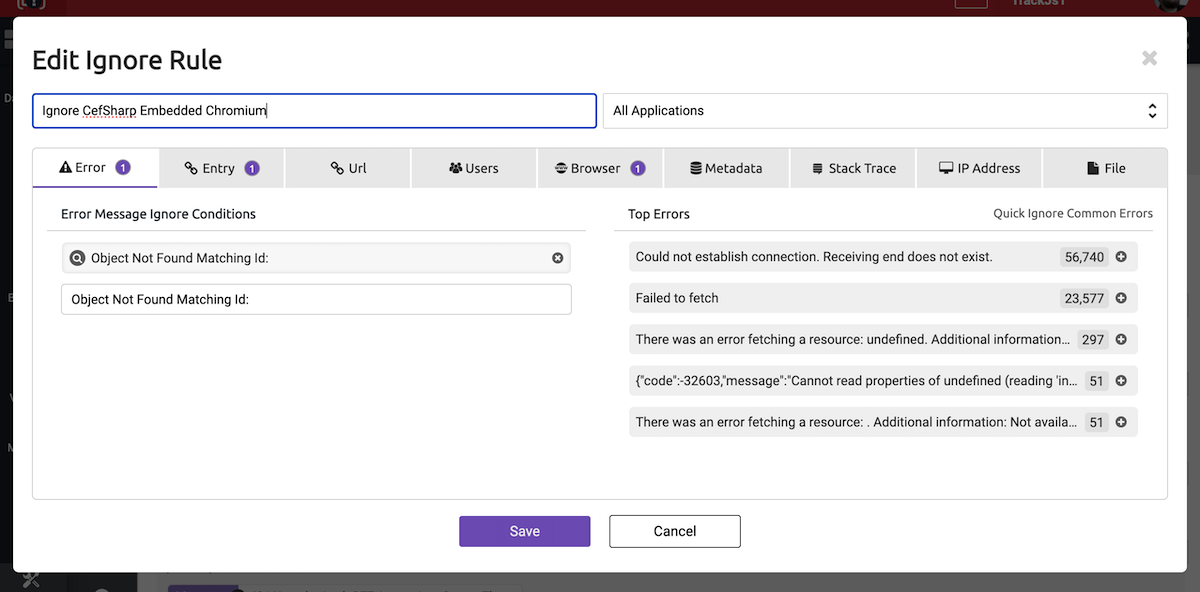This distinctive error message started appearing in large volumes across many websites beginning in April 2024. The error appears hundreds of times from the same “user” sessions, which can be alarming when first encountered in error monitoring.
The error signature - with its specific format mentioning “Id”, “MethodName”, and “ParamCount” - is not generated by standard browsers or common JavaScript frameworks. Instead, it is the signature of the CefSharp Chromium bot crawling your website.
Important: This error represents bot traffic, not real user problems, so it should typically be filtered out of error monitoring.
The Problem
“Object Not Found Matching Id:1, MethodName:update, ParamCount:4” is generated by the CefSharp library, a .NET wrapper around the Chromium browser engine. The numbers in the error message (Id, ParamCount) vary depending on the specific website and bot interaction, but the format remains consistent.
This error occurs when bots using CefSharp attempt to interact with JavaScript objects on your page that may not exist or behave as expected in the automated browsing context.

Here’s the specific line in their source code.
Key point: This error indicates automated bot traffic visiting your site, not legitimate user interactions that need fixing.
Understanding the Root Cause
“Object Not Found Matching Id…” errors originate from several types of automated systems scanning your website:
1. Microsoft Outlook SafeSearch
Most common source: Microsoft Outlook’s SafeSearch feature scans links in emails to verify they’re safe before users click them. This is likely the primary source of these errors.
How to identify: Errors occur when someone emails a link to your website to an Outlook user, triggering an automated safety scan.
2. Security Scanning Bots
Various security services and enterprise email filters use CefSharp-based crawlers to analyze websites for potential threats.
How to identify: Regular, automated visits that don’t correspond to typical user behavior patterns.
3. Content Indexing Crawlers
Some specialized crawlers use CefSharp to render JavaScript-heavy pages for indexing or analysis purposes.
How to identify: Systematic crawling patterns that attempt to interact with dynamic page elements.
4. AI Training and Data Collection
Machine learning systems may use CefSharp-based crawlers to gather training data from websites.
How to identify: High-volume, repetitive interactions that don’t follow normal user navigation patterns.
5. Enterprise Web Filtering
Corporate firewalls and web filtering systems often pre-scan websites that employees attempt to visit.
How to identify: Errors that correlate with corporate network access patterns.
How to Fix “Object Not Found Matching Id”
Quick Troubleshooting Checklist
- Recognize this as bot traffic, not user issues
- Configure error monitoring to ignore CefSharp-related errors
- Monitor for patterns that might indicate malicious bot activity
The primary “fix” is recognizing that this isn’t actually broken functionality requiring repair:
The only step: Configure Error Monitoring Filters
Set up ignore rules to filter out CefSharp bot errors:
TrackJS Ignore Rule Configuration:

Programmatic filtering:
// TrackJS configuration to ignore CefSharp errors
TrackJS.install({
token: 'your-token-here',
onError: function(payload) {
// Filter out CefSharp bot errors
if (payload.message && payload.message.includes('Object Not Found Matching Id:')) {
console.log('Filtered CefSharp bot error:', payload.message);
return false; // Don't track this error
}
// Filter based on user agent if available
if (payload.metadata && payload.metadata.userAgent) {
const ua = payload.metadata.userAgent.toLowerCase();
if (ua.includes('cefsharp') || ua.includes('safesearch')) {
return false; // Don't track bot traffic
}
}
return true; // Track other errors normally
}
});
When to Ignore This Error
“Object Not Found Matching Id” should almost always be ignored because:
- Not user traffic: Errors come from automated bots, not real users
- No user impact: Bots encountering JavaScript errors doesn’t affect user experience
- Expected behavior: Security scanning and link verification are normal web activities
- High noise: These errors can generate significant volume without indicating problems
However, investigate if you notice:
- Correlation with outages: Sudden spikes coinciding with site accessibility issues
- Malicious patterns: Unusually aggressive bot behavior that might indicate attacks
- SEO impact: If legitimate crawlers are having similar issues affecting search indexing
Summary
“Object Not Found Matching Id:1, MethodName:update, ParamCount:4” is a signature error from CefSharp-based crawlers, particularly Microsoft Outlook’s SafeSearch feature. This error represents automated security scanning and link verification, not user-facing problems.
The appropriate response is filtering these errors out of your monitoring system while potentially tracking volume trends. These errors actually indicate that security systems are successfully accessing and scanning your website, which is generally positive.
Remember: Bot traffic errors are a normal part of the modern web ecosystem. The key is distinguishing between bot noise and actual user issues that require attention.


